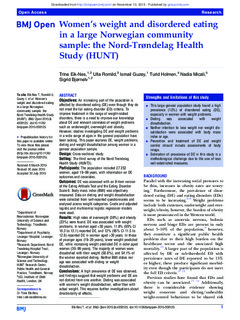| dc.description.abstract | Objectives: An increasing part of the population is affected by disordered eating (DE) even though they do not meet the full eating disorder (ED) criteria. To improve treatment in the range of weight-related disorders, there is a need to improve our knowledge about DE and relevant correlates of weight problems such as underweight, overweight and obesity. However, studies investigating DE and weight problems in a wide range of ages in the general population have been lacking. This paper explores DE, weight problems, dieting and weight dissatisfaction among women in a general population sample.
Design: Cross-sectional study.
Setting: The third survey of the Nord-Trøndelag Health Study (HUNT3).
Participants: The population included 27 252 women, aged 19–99 years, with information on DE outcomes and covariates.
Outcomes: DE was assessed with an 8-item version of the Eating Attitude Test and the Eating Disorder Scale-5. Body mass index (BMI) was objectively measured. Data on dieting and weight dissatisfaction were collected from self-reported questionnaires and analysed across weight categories. Crude and adjusted logistic and multinomial logistic regression models were used.
Results: High rates of overweight (38%) and obesity (23%) were found. DE was associated with weight problems. In women aged <30 years, 11.8% (95% CI 10.3 to 13.1) reported DE, and 12% (95% CI 11.5 to 12.6) reported DE in women aged >30 years. In those of younger ages (19–29 years), lower weight predicted DE, while increasing weight predicted DE in older aged women (30–99 years). The majority of women were dissatisfied with their weight (58.8%), and 54.1% of the women reported dieting. Neither BMI status nor age was associated with dieting or weight dissatisfaction.
Conclusions: A high prevalence of DE was observed, and findings suggest that weight problems and DE are not distinct from one another. Dieting was associated with women's weight dissatisfaction, rather than with actual weight. This requires further investigations about directionality of effects. | nb_NO |
| dc.description.localcode | This is an Open Access article distributed in accordance with the Creative Commons Attribution Non Commercial (CC BY-NC 4.0) license, which permits others to distribute, remix, adapt, build upon this work non-commercially, and license their derivative works on different terms, provided the original work is properly cited and the use is non-commercial. See: http://creativecommons.org/licenses/by-nc/4.0/ | nb_NO |
